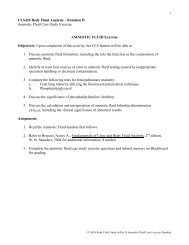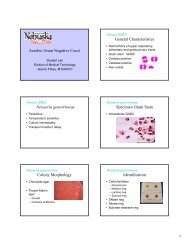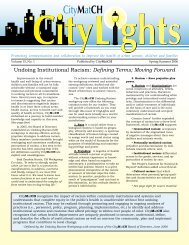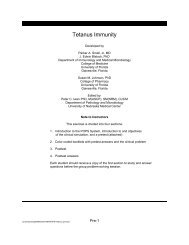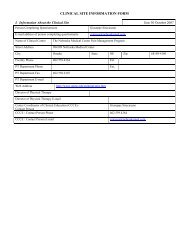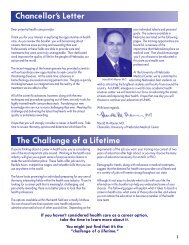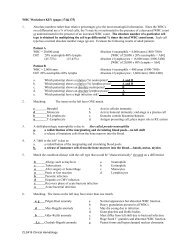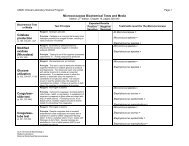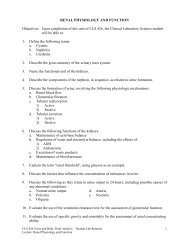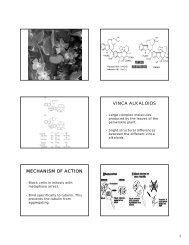Drugs Used to Treat Spasticity - UNMC
Drugs Used to Treat Spasticity - UNMC
Drugs Used to Treat Spasticity - UNMC
You also want an ePaper? Increase the reach of your titles
YUMPU automatically turns print PDFs into web optimized ePapers that Google loves.
492 Kita & Goodkin<br />
The half-life for oral dantrolene is approximately<br />
15 hours, with peak concentrations occurring<br />
within 3 <strong>to</strong> 6 hours. It is metabolised largely by the<br />
liver. Dantrolene therapy is initiated at 25 mg/day<br />
and slowly titrated upwards by increments of 25<br />
mg/day every 5 <strong>to</strong> 7 days, with a recommended<br />
maximum of 400 mg/day in divided doses. Because<br />
its site of action is peripheral, the most common<br />
adverse effect of dantrolene is weakness. For<br />
this reason, dantrolene may be most appropriate for<br />
those patients who are non-ambula<strong>to</strong>ry with severe<br />
spasticity. Other adverse effects include drowsiness,<br />
diarrhoea and malaise. Hepa<strong>to</strong><strong>to</strong>xicity, which<br />
can be irreversible, is the major concern with dantrolene<br />
and those patients who are being considered<br />
for therapy should have liver function tests<br />
checked prior <strong>to</strong> initiating therapy and on a regular<br />
basis (every 3 months) thereafter.<br />
3.6 Gabapentin<br />
Gabapentin was first introduced in 1994 as a<br />
new treatment option for patients with partial seizures.<br />
[58] It is structurally similar <strong>to</strong> GABA, exerting<br />
GABAnergic activity by binding recep<strong>to</strong>rs in<br />
the neocortex and hippocampus. However, it does<br />
not bind conventional GABA A , GABA B ,glycine,<br />
glutamate, benzodiazepine or N-methyl aspartate<br />
recep<strong>to</strong>rs. [59,60] It is easily absorbed, reaching peak<br />
plasma concentrations in 2 <strong>to</strong> 3 hours, it is not protein<br />
bound, does not undergo metabolism, and is<br />
excreted unchanged in the urine. It is well <strong>to</strong>lerated<br />
indosagesup<strong>to</strong>3600mg/day. [61] Recent studies<br />
and reports have suggested it might be effective as<br />
another <strong>to</strong>ol in treating spasticity [61,62] but further<br />
studies will be necessary <strong>to</strong> confirm efficacy.<br />
3.7 Botulinum Toxin<br />
Botulinum <strong>to</strong>xin is a product of Clostridium botulinum,<br />
and ingestion of the organism or its spores<br />
results in botulism. Botulinum <strong>to</strong>xin blocks presynaptic<br />
release of acetylcholine from the nerve<br />
terminal. Seven immunologically distinct <strong>to</strong>xins<br />
(type A through G) have been purified. Local intramuscular<br />
injection of botulinum <strong>to</strong>xin A has been<br />
approved for the treatment of strabismus and<br />
blepharospasm associated with dys<strong>to</strong>nia. When injected,<br />
the agent spreads through muscle and fascia<br />
approximately 30mm, binding presynaptic cholinergic<br />
nerve terminals, resulting in a chemical denervation.<br />
Botulinum <strong>to</strong>xin injection has been studied as a<br />
treatment for severe spasticity caused by stroke, traumatic<br />
brain injury and other causes, [63-66] and has<br />
been found <strong>to</strong> be effective in reducing muscle <strong>to</strong>ne<br />
and spasms. Snow et al. [67] studied botulinum <strong>to</strong>xin<br />
A in 9 patients with advanced MS (wheelchair- or<br />
bed-bound) in a randomised, crossover, doubleblind<br />
study. Muscle <strong>to</strong>ne, frequency of spasms and<br />
hygiene/self-care scores were used <strong>to</strong> assess efficacy.<br />
Botulinum <strong>to</strong>xin injection produced a significant<br />
reduction in spasticity and improvement in ease<br />
of nursing care, with no adverse effects. [67] Botulinium<br />
<strong>to</strong>xin injection was found <strong>to</strong> be a promising<br />
therapy for the treatment of spasticity in children<br />
with cerebral palsy. [68,69] Judicious use of botulinum<br />
<strong>to</strong>xin may permit surgery <strong>to</strong> be delayed until children<br />
reach a more suitable age.<br />
Although botulinum <strong>to</strong>xin injection is off-label<br />
for treatment of spasticity, it may be an appropriate<br />
option for selected patients with severe localised<br />
spasms. Physicians using botulinum <strong>to</strong>xin should<br />
be trained in its use with attention <strong>to</strong> relevant <strong>to</strong>pical<br />
ana<strong>to</strong>my and kinesiology. Onset of focal muscle<br />
fibre paralysis begins in 24 <strong>to</strong> 72 hours with a<br />
maximal effect seen at 5 <strong>to</strong> 14 days. The paralysis<br />
is transient lasting 12 <strong>to</strong> 16 weeks. Localising specific<br />
muscles with electromyographic guidance<br />
may be necessary <strong>to</strong> produce optimal effects. Injection<br />
site reactions can occur and antibodies may<br />
develop <strong>to</strong> specific immunological strains, thus<br />
limiting efficacy. Because the delivery of <strong>to</strong>xin is<br />
not entirely contained, the paralysis of muscles<br />
may not be exact. Excessive weakness, though ultimately<br />
reversible, may result.<br />
3.8 Intrathecal Baclofen<br />
When treatment with oral medication fails in a<br />
patient with persistent severe spasticity, intrathecal<br />
administrationofbaclofenshouldbeconsidered.A<br />
pump with reservoir is surgically implanted in the<br />
© Adis International Limited. All rights reserved. <strong>Drugs</strong> 2000 Mar; 59 (3)




